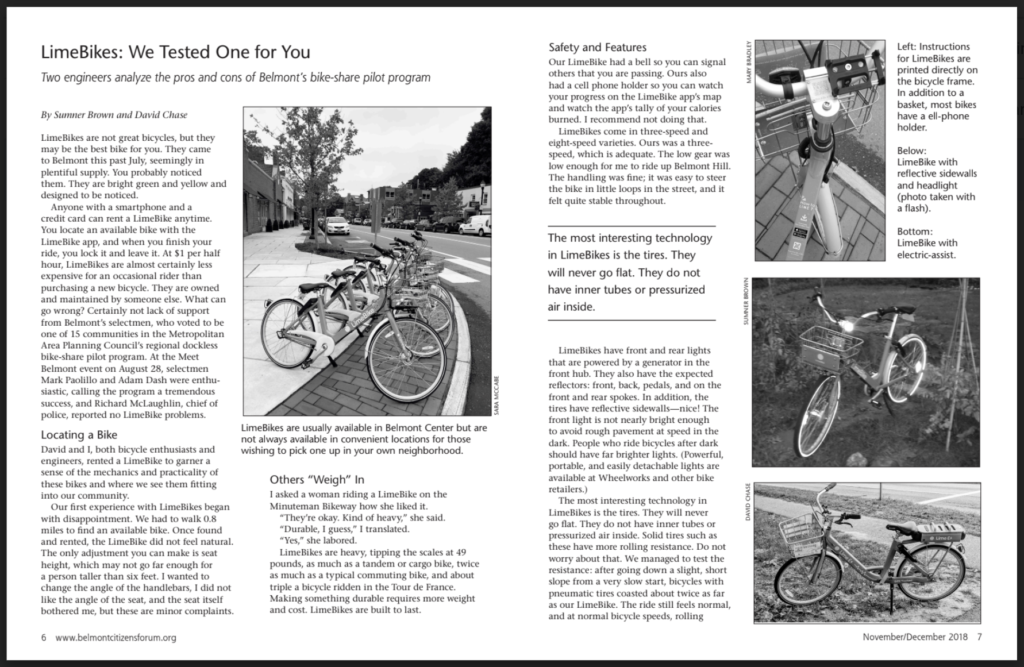By Evanthia Malliris
The article about LimeBikes in Belmont in our November/December BCF Newsletter issue drew several responses from our readers. Authors Sumner Brown and David Chase—both engineers, expert all-weather cyclists, and BCF board members—took a LimeBike out for a spin and reported on their experience.

Rachel Berger expressed her concern that bike-sharing services don’t include helmets, and she encouraged potential LimeBikers to buy a helmet before taking their first ride.
Sumner responded that he wore a helmet during his LimeBike test drive, though he “may be the only one.” Helmets are not expensive and are a handy place to mount two additional lights. He thinks that helmets work best in protecting the brain in accidents where a rider falls headfirst from his seated height.
“There’s something different about bike share,” David added. “Because every trip is paid for, we know how many trips are taken, and we keep track of fatalities, and so far, bike share has been very, very safe—per trip, safer than driving, even. It’s not entirely clear why, but bike-share users tend to be slower (which is safer) and bike-share bikes all have daytime lights (which studies show cut the crash rate). In at least one comparison of bike share versus other local cyclists around Washington, DC, a higher proportion (though still a minority) of bike-share users are women, and women tend to be much safer (whether biking, driving, walking, or motorcycling).”
David delved deeper and found that one particular problem with bicycle helmets has been their inability to reduce the per-cyclist death rate when they are made mandatory. (The per-cyclist risk stays the same or increases, though mandatory helmets tends to reduce cycling use overall, which can cut the overall rate of deaths and head injuries.) There are several hypotheses as to why this happens:
- Risk compensation by cyclists—helmet cyclists take more risks (approximately proven);
- Risk compensation by drivers—drivers are less careful around cyclists in helmets (proven);
- Selection effects—the most careless cyclists just break the law;
- Selection effects—the most careful cyclists take helmet promotion as a signal that cycling is unsafe, and quit;
- Failures in helmet design—real world crashes are not lab crashes.
Note that LimeBike literature makes the point that if helmets are required by local ordinance, you must use a helmet.
Geoff Dutton wrote in to say that he found the article helpful; he’d been wondering about the bikes stranded all over town. However, he finds the subscription-based cost of LimeBikes to be too expensive, since many weeks might elapse between rides. He suggests that a payment model such as a prepaid phone card, cell phone, or FastLane-type device might make using LimeBikes more attractive. As Sumner reported in the story, he had enrolled in LimeBike’s $30/month plan, and it took quite an effort to remove himself from this plan. He had been unaware of an alternative pay option that charges per-ride. It appears that riders can use a credit card to purchase a minimum $10 credit on the LimeBike app, after which they will be charged $1 each time they unlock a bike plus five cents per minute for each ride. Students, faculty, and staff with a valid “.edu” email address can receive a 50 percent discount.
————–
Look for an article in the spring about how to buy a bike. Sumner Brown will interview WheelWorks co-owner Peter Mooney, who rides to work and builds bicycle frames.


Sorry, the comment form is closed at this time.